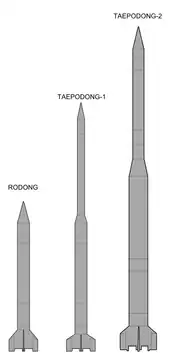| Taepodong-1 | |
|---|---|
 | |
| Type | technology demonstrator |
| Service history | |
| Used by | |
| Production history | |
| Manufacturer | |
| Specifications | |
| Mass | 33.4 tons |
| Length | 25.8 m |
| Diameter | 1.8 m |
| Engine | liquid-fueled |
Guidance system | inertial |
| Taepodong-1 | |
| Chosŏn'gŭl | 대포동-1 |
|---|---|
| Hancha | 大浦洞-1 |
| Revised Romanization | Daepodong-1 |
| McCune–Reischauer | Taep'odong-1 |
Taepodong-1 (Korean: 대포동-1) was a three-stage technology demonstrator developed by North Korea, a development step toward an intermediate-range ballistic missile. The missile was derived originally from the Scud rocket and was tested once in 1998 as a space launch vehicle. As a space launch vehicle, it was sometimes called the Paektusan 1.[1]
History


①: Taepodong-1 ②: Unha-2 ③: Unha-3 ④: Kwangmyŏngsŏng (Unha-3) ⑤: Hwasong-12 ⑥: Hwasong-12
On August 31, 1998, North Korea announced that they had used this rocket to launch their first satellite Kwangmyŏngsŏng-1 from a pad on the Musudan-ri peninsula. However, the satellite failed to achieve orbit; outside observers conjecture that the additional third stage either failed to fire or malfunctioned.[2] This is contrary to official statements of the North Korean state media, which stated that the satellite achieved orbit about 5 minutes after launch.[3] On this single launch, the main two-stage booster flew for 1,646 km without any significant problems.[4]
The rocket was launched eastward, passing over Japan at an altitude of over 200 km. The second stage came down into the Pacific Ocean about 60 km past Japan, and the third stage about 600 km beyond Japan.[5] According to post-launch analysis of the launch vehicle, debris from the third stage fell as far as 4,000 kilometers from the launch pad. Some analysts believe that a three-stage space booster variant of the Taepodong-1 could be capable of travelling as far as 5,900 kilometers with a very small payload.[6]
In 2003 the US Defense Intelligence Agency reported to the Congress: "We have no information to suggest Pyongyang intends to deploy the Taepo Dong 1 (TD-1) as a surface-to-surface missile in North Korea. We believe instead that the vehicle was a test bed for multi-stage missile technologies."[7] In 2009 the US National Air and Space Intelligence Center assessed that the Taepodong-1 was a technology demonstrator, a development step toward longer-range missile development.[8]
The Taepodong-2, or Unha-2, was the successor to the Taepodong-1 technology demonstrator, with a first (unsuccessful) test launch in 2006.[9]
Description
- Liftoff thrust: 525.25 kN
- Total mass: 33,406 kg
- Diameter: 1.80 m
- Length: 25.80 m
- Range with 1,500 kg of payload: 2,000 km
- Range with 1,000 kg of payload: 2,500 km
- Range with 50 kg of payload and third stage: 6,000 km[10]
The rocket's first stage is a Rodong-1 MRBM, and the second stage uses a single engine from the Rodong-1.[1]
In a nominal space launch, the first stage burns for 95 seconds, before separating, and landing about 250 kilometres (160 mi) downrange. The payload fairing separates 144 seconds after launch. This is followed by the depletion and separation of the second stage, 266 seconds into the flight, resulting in an impact about 1,650 kilometres (1,030 mi) downrange. The third stage, which is spin-stabilised, then burns for 27 seconds to insert the payload into low Earth orbit. The payload is estimated at 6 kg mass.[1]
See also
References
- 1 2 3 Wade, Mark. "Paektusan 1". Encyclopedia Astronautica. Archived from the original on December 27, 2016. Retrieved 27 April 2017.
- ↑ "A History of Ballistic Missile Development in the DPRK". Center for Nonproliferation Studies Occasional Papers. Archived from the original on 2001-11-11. Retrieved 2006-04-08.
- ↑ Broadcast excerpted in "Kwangmyongsong". Encyclopedia Astronautica. Archived from the original on 2006-04-22. Retrieved 2006-04-08.
- ↑ Все названия испытываемых в КНДР ракет в иностранной печати придуманы, RIA Novosti, 07-07-2006.
- ↑ "Response of the Defense Agency to the Missile Launch by North Korea". Defense Agency (Japan). Federation of Atomic Scientists. Retrieved 29 August 2017.
- ↑ CRS report for Congress.
- ↑ U.S. Senate Select Committee on Intelligence, World Wide Threat Hearing, 11 February 2003.
- ↑ Ballistic and Cruise Missile Threat (PDF). National Air and Space Intelligence Center (Report). Air Force Intelligence, Surveillance and Reconnaissance Agency. April 2009. NASIC-1031-0985-09. Retrieved 20 February 2013.
- ↑ "CNN.com - U.S. officials: North Korea tests long-range missile - Jul 4, 2006". CNN. July 5, 2006. Retrieved 2023-12-19.
- ↑ Pekdosan-1 ("Taepodong-1"), skyrocket.de.